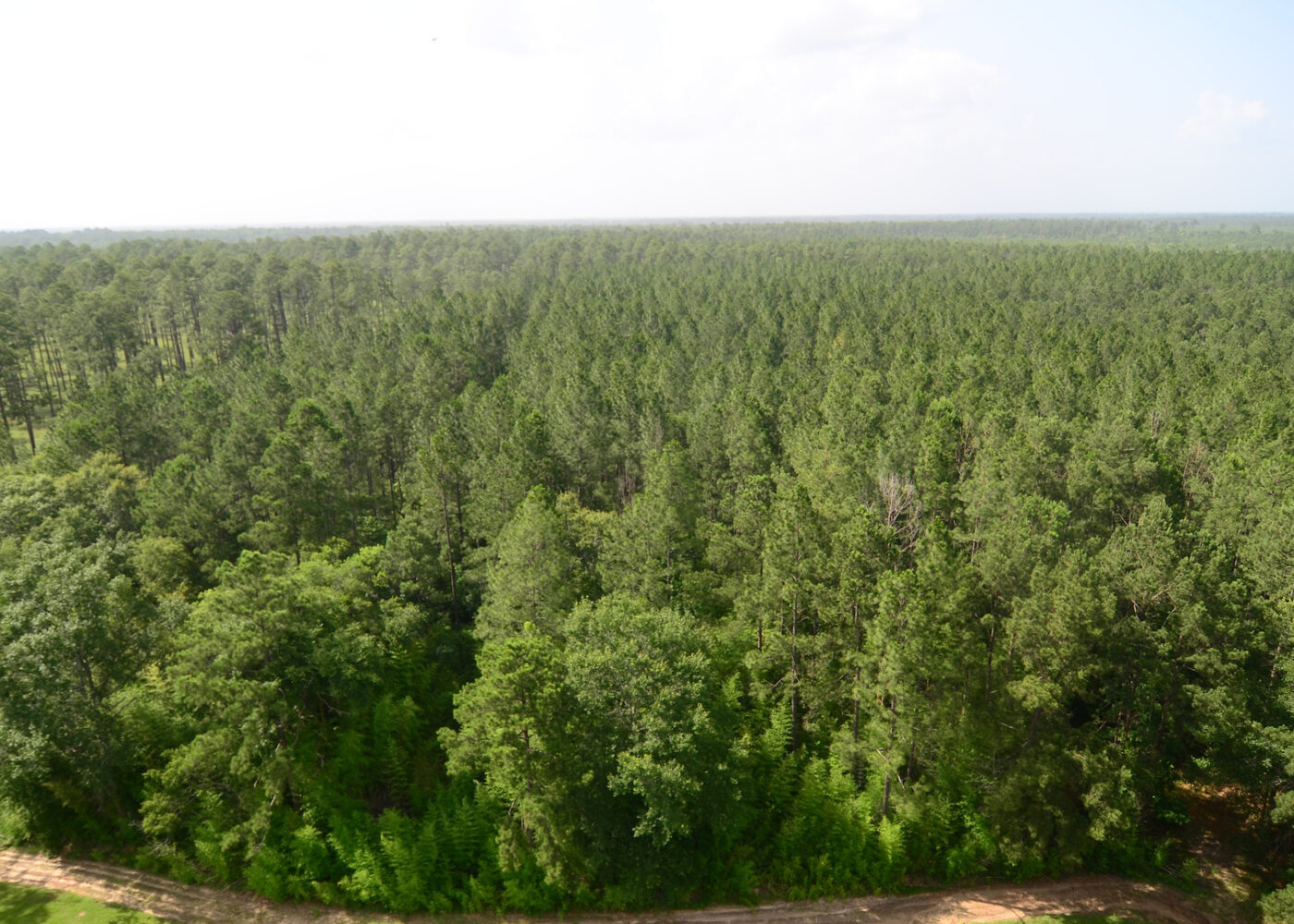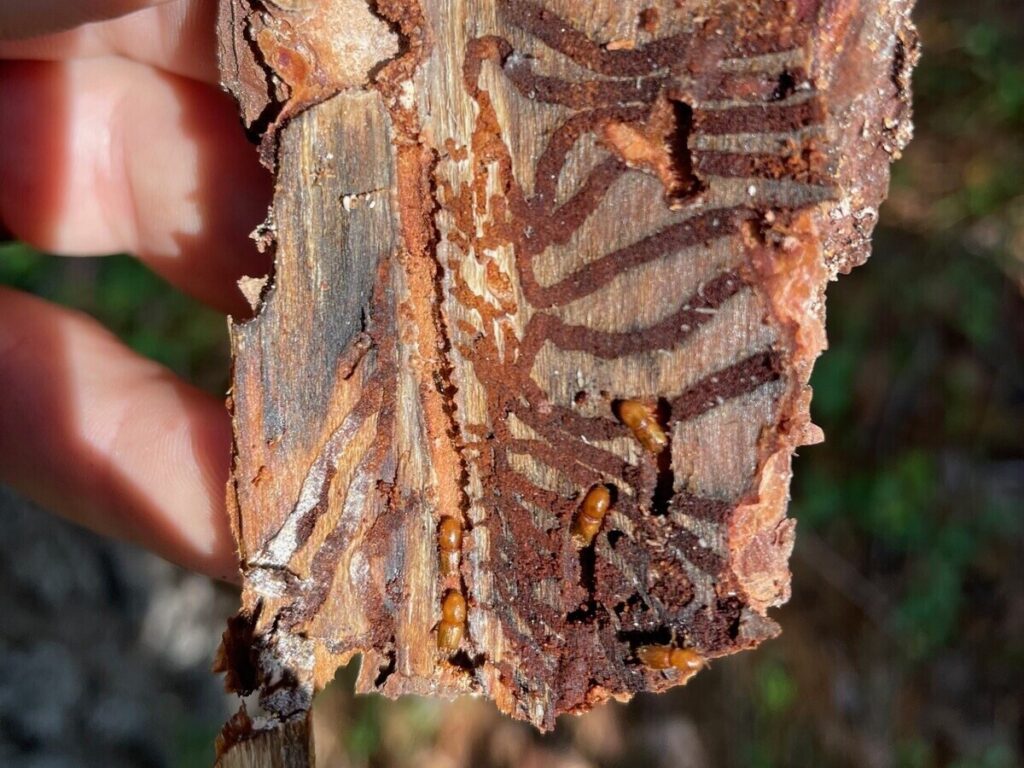Pine engraver, or Ips beetles, are three related species of beetle that eat into the bark and cambium of pine trees who have been stressed through disturbances like drought, intense fire, or hail. Very old trees are also more susceptible to attack.
Unlike the southern pine beetle, they rarely kill trees by themselves. Instead, they are usually one of many factors leading to a tree’s death. Infestations are usually limited to one or two trees at a time. In rare cases they may infest an entire stand if all of the trees are simultaneously stressed.
Pine engravers beetles are small, cylindrical insects ranging from brown to black in color. They include three separate species that are differentiated by the number of spines on each side of their abdomen, and the portion of tree their species colonizes.
- The eastern six-spined engraver beetle, Ips calligraphus, is about 5 mm long and tends to inhabit large-diameter material, like a tree’s trunk or large branches.
- The eastern five-spined engraver beetle, Ips grandicollis, is about 4 mm long, and is usually found in medium-sized material like the upper trunk and large branches or in small diameter trees.
- The small southern pine engraver, Ips avulsus, is about 3 mm long, and is almost always confined to branches in the tops of trees.
Evidence of beetle attacks
Pitch tubes
Pine engraver beetles leave behind several indications of their presence as they enter and infest a tree. One of the first and more noticeable signs will be pitch tubes, outflows of pine pitch (also called resin) from the bark of the tree. The tree produces this in attempt to close the point of attack of the engraver beetles and push them out of the tree or trap them.
Pine pitch is the second line of defense after the tree’s bark, but trees suffering through drought conditions or compromised immune systems may not be able to produce pitch in enough quantity to stop all intrusions. A pitch tube will normally look like a small extrusion of opaque reddish or whitish substance hanging onto the bark of the tree. Pitch tubes from pine engraver beetles will normally extend out from the plates of the bark, and have a more reddish-brown color, from the frass that gets trapped in the resin.
Frass
As the beetles chew their way through the bark of the pine tree, they’ll deposit frass, also known as boring dust. The reddish-brown powder will often collect at the trunk of an attacked pine, or in the cracks between plates in the bark of the tree.
Flagging foliage
The next visible characteristic of attack will be the foliage, or needles, of the tree turning from green to yellow to red. During the heat and drought typical of late summers in east Texas, an infested tree’s needles may turn from green to red over around three weeks.
Comparatively, needles of a beetle-killed pine in the winter may remain green for two months or even more because of the cooler temperatures and higher moisture. Once the needles turn red, the tree is dead and cannot be saved.
“If the needles are red, the tree is dead.”
Pine trees that have been attacked by pine beetles were likely already stressed or dying, and unlikely to recover. Pine engraver beetles can also sometimes attack only the upper portion of the tree and kill the top but have yet to attack the lower portion of the tree. In those cases, it may be impossible to spot pitch tubes or frass, making diagnosis difficult.
Galleries
As the beetles eat their way into the bark, they create form small tunnels, or galleries. For pine engraver beetles, the galleries will have a distinct vertical element to them, often forming “Y”, “H”, and “I” patterns.
Multiple female engraver beetles often meet with one or a couple males to mate in a nuptial chamber to mate, after which each female creates a vertical egg chamber.
After the eggs hatch, the larva will eat their way up the bark of the tree, before eventually pupating and becoming an adult beetle. From there, the adults bore their way out of the bark of the tree, leaving a hole, often no larger than a wooden pencil lead, to start the process all over again at a new pine.
Prevention and control
Maintaining healthy trees is the best way to prevent pine engraver beetles.
Forest control
In a forest stand, responsible management practices also tend to be good beetle prevention practices. Direct control is rarely needed for an infestation of engraver beetles in a forested environment.
If only a few trees have been attacked, doing nothing is often an acceptable choice. If active control is deemed necessary, though, cutting and removing the infested trees from the property is the best course of action.
Felling the trees and leaving them in place is not be beneficial. In addition, removing trees that the beetles have already emerged from isn’t recommended, nor is cutting down a radius of green, healthy trees around the infested trees.
Yard control
For protecting pines in your yard from pine engraver beetles, maintaining healthy trees is still the best way to mitigate risks of infestation. Root damage caused by construction and drought are the two most common stress factors for the pine trees in your lawn.
Watering trees slowly and deeply during periods of drought, reducing risks of soil compaction around your trees’ roots, and avoiding damage to root systems are your best and easiest means of preventing pine engraver beetle attacks.
Visibly infested trees that contain some life stage of the pine beetle should probably be removed but consult a forestry professional before making such a decision.
If a beetle-killed tree is removed, care should be taken to not damage the other, un-infested pine trees present on the property. Trees wounded in this manner will be more vulnerable to attack by pine beetles. As in a forest stand, removing trees from which the engraver beetles have already emerged is not beneficial for stopping an infestation.
If the dead trees are positioned so that they could eventually fall on structures, roads, power lines, fences, or so on, they should be considered hazardous and removed. It will generally take six to 10 months after a pine tree dies for it to decay enough that large limbs, the top, or the trunk may break, but it is safer to remove dead pines in dangerous positions sooner rather than later.
Chemical control
We rarely recommend that landowners treat for pine engraver beetles, and instead generally suggest that you let the beetle infestation run its course, or to preemptively cut the tree down before it dies and potentially becomes more dangerous as it rots.
It’s generally cost-prohibitive to chemically treat for beetles at scale, and usually isn’t necessary, so long as responsible forestry management is practiced. So treating trees with insecticide to prevent beetle infestation is usually reserved for singular trees of special value to their owner.
In these specific cases, use of insecticide may be effective in prevention and control. Systemic insecticides can be very effective in controlling bark beetles and are generally applied via either a soil-drench method or direct injection into the trunk.
- Soil-drench applications are usually more expensive, require more frequent applications, and take longer to be absorbed into the tree through its roots, which can delay protection.
- Direct injection of insecticides is more expensive because of the specialized equipment that’s utilized, but applications are required less frequently, and absorption occurs much more rapidly.
Not all chemicals and not all formulations of chemicals are created equal. You should consult with your local forester to learn about the most current, effective treatment options.
Spraying insecticides on your pine trees for controlling bark beetles is largely ineffective, due to the lack of exposure to the infesting insects. For it to be effective at all, the entire tree must be sprayed, so that the insecticide can soak through the bark, but this is largely impractical.

